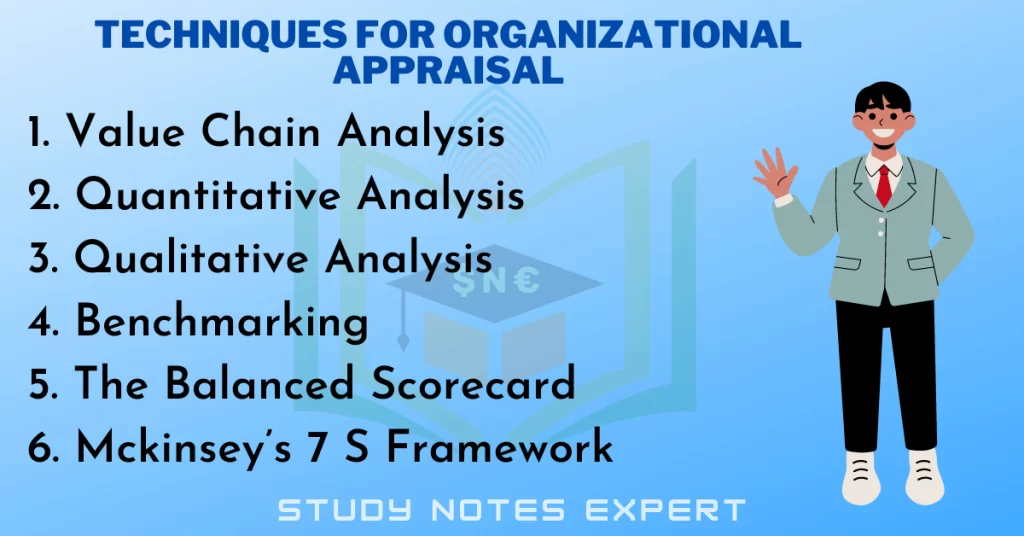Techniques for Organizational Appraisal
The techniques for organizational appraisal may classify into the following categories:

1. Value Chain Analysis
Value Chain Analysis (VCA) is the method that allows an organization to recognize its primary and supporting functions that make the product more valuable. It also assists in evaluating these processes to decrease costs or increase differentiation as techniques for organizational appraisal. VCA is a tool for strategic analysis helpful for the companies to analyze their internal processes.
2. Quantitative Analysis
One of the most popular methods used for the analysis of the effectiveness of a firm is through numbers. Financial figures are the techniques for organizational appraisal that are typically helpful for the assessment of performance as well as to determine strengths and weaknesses. However, there are other ways to assess since many other numbers are reliable. The financial analysis, followed by the non-financial quantitative analysis, will be explained below.
i) Financial Analysis
Financial analysis is an internal techniques for organizational analysis. Executives and entrepreneurs, financiers, shareholders and shareholders typically use it. Who’s primary concern is making decisions concerning the investment. It is typically helpful with the aim to assess the financial health of the company. The main drawback is that it obscures the financial situation of various company areas. Still, it helps reveal the overall picture of the company’s financial situation.
Despite its shortcomings, it is an effective method since it allows the management to make the necessary modifications. It is a part of techniques for organizational appraisal. Also, it ensures that accounting standards provide the respect they deserve. The three principal analysis techniques include ratio analysis, value-added economic analysis, and activities-based cost accounting.
ii) Non-Financial Analysis
The objective of using the quantitative analysis of non-financial resources, techniques for organizational appraisal, is to aid in assessing the organization. Financials are not able to explain every business activity. While a business could quantify non-material aspects such as the goodwill of the company and the morale of employees, it is not a good idea to measure the same in terms of finance.
3. Qualitative Analysis
Although the assessment of an organization is through quantitative analysis because it is possible to measure and compare based on financial figures and numbers, there are a lot of issues with quantification, as the majority of strategists understand. The qualitative assessment must complement qualitative analysis, conducted by analyzing the viewpoint of and judgement or an assumption.
Qualitative analysis, techniques for organizational appraisal, is generally less invasive than quantitative analysis based on figures. But that doesn’t mean that qualitative research is unreliable or based on emotions and imagination. On the contrary, it is practiced by involving various aspects of the mental faculties rather than the initial quote of figures, as in the case of qualitative analysis.
4. Benchmarking
Benchmarking aims to recognize “the most effective practices” for the products and procedures that govern the development and delivery of goods. The reason at heart of benchmarking is to identify and assess the current state of a company or organization in terms of “best practices” within the field and to recognize areas and strategies to enhance performance. It is the techniques for organizational appraisal. The search for “best practices” may occur within an industry but can helpful in other sectors.
5. The Balanced Scorecard
At the beginning of the 19″ century, balance score cards were introduced in the early 19th century by Robert Kaplan and David Norton as a method of evaluation of performance. It evaluates the organization’s performance by examining it from different perspectives. These views can attribute to the fact that leaders must consider other aspects of the organization’s performance to assess their contribution to the organization.
The current balance scorecard is a brand-new method of evaluation. According to this model, it’s an extensive method of evaluating performance that provides an even balance between unconventional operations and financial techniques. It is one of the important techniques for organizational appraisal.
6. Mckinsey’s 7 S Framework
The McKinsey 7S Framework is a management system developed by well-known consultants to business Robert H. Waterman, Jr. and Tom Peters in the 1980s. The seven S’s are strategies, structure style, skills of employees, shared values, and staff. It is techniques for organizational appraisal, typically helpful as an analysis tool for organizations to evaluate and monitor changes to the internal conditions of an organization.
What are Appraisal Techniques?
Appraisal techniques are methods used to estimate the value of something. There are many different appraisal techniques, and the one used depends on the type of property valued and the appraisal’s purpose. Some standard appraisal techniques include the market approach, the income approach, and the cost approach.
What is the Best Appraisal Technique?
The different appraisers may have different opinions. Some appraisers may prefer to use the sales comparison approach, while others may prefer the cost approach. Ultimately, the best appraisal technique is the one that produces the most accurate and reliable estimate of value for the property is appraised.


Usually I don’t learn post on blogs, however I wish to say that this write-up very forced me to check out and do so! Your writing style has been amazed me.
Thanks, quite nice article.